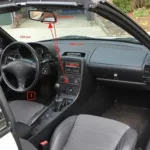OBD2 scanners are indispensable tools for car owners and mechanics alike, providing a wealth of information about a vehicle’s health and performance. But what is data from obd2 scanner called? This article dives deep into the world of OBD2 data, exploring its various names, formats, and the wealth of insights it can unlock. We’ll explore everything from basic diagnostic codes to advanced performance parameters, empowering you to understand your vehicle better. Check out our guide on lescars obd2 for more information on specific scanner models.
Decoding the Language of Your Car: OBD2 Data Terminology
OBD2 data, also known as diagnostic trouble codes (DTCs), is the lifeblood of vehicle diagnostics. These codes, along with other data parameters, provide a snapshot of your car’s internal workings, revealing potential issues and performance indicators. Understanding this data is crucial for effective troubleshooting and maintenance.
Diagnostic Trouble Codes (DTCs): The Foundation of OBD2 Data
The most common term for data from an OBD2 scanner is “Diagnostic Trouble Codes,” or DTCs. These alphanumeric codes are standardized across vehicles manufactured after 1996 in the United States, simplifying the diagnostic process. Each code corresponds to a specific fault or malfunction within the vehicle’s systems. For example, the code P0420 indicates a problem with the catalytic converter system.
Besides DTCs, OBD2 scanners also provide access to a wide range of live data, often referred to as “data parameters” or “PIDs” (Parameter IDs). These parameters offer real-time insights into various sensors and systems, including engine speed, coolant temperature, oxygen sensor readings, and much more. This data can be invaluable for identifying intermittent problems or monitoring performance trends. You can learn more about specific applications with our guide on obd2 code reader 0xford.
Beyond the Basics: Exploring Different Types of OBD2 Data
While DTCs are the cornerstone of OBD2 diagnostics, there are other forms of data retrieved by these scanners that offer a deeper understanding of your vehicle’s performance. Let’s delve into these data types.
Freeze Frame Data: Capturing the Moment of Fault
Freeze frame data provides a snapshot of the vehicle’s operating conditions at the exact moment a fault code was stored. This data can include engine speed, coolant temperature, vehicle speed, and other relevant parameters, providing valuable context for diagnosing the root cause of the problem.
Readiness Monitors: Ensuring Emissions Compliance
Readiness monitors track the performance of various emissions-related systems. They indicate whether these systems have completed their self-tests and are functioning correctly. Incomplete readiness monitors can prevent a vehicle from passing emissions inspections.
“Understanding the various data points an OBD2 scanner provides is like having a conversation with your car,” says Amelia Carter, a seasoned automotive diagnostician. “It empowers you to identify and address potential issues before they become major problems.”
Oxygen Sensor Data: Monitoring Engine Combustion Efficiency
Oxygen sensors play a vital role in maintaining the correct air-fuel mixture for optimal combustion. OBD2 scanners can display live oxygen sensor data, allowing you to monitor their performance and identify potential issues like a failing sensor or a vacuum leak. Looking for specific car models? Check out our article on hyundyi sonata obd2 programmer.
Unleashing the Power of OBD2 Data: Practical Applications
Understanding what is data from obd2 scanner called and how to interpret it opens up a world of possibilities for car owners and mechanics.
DIY Diagnostics and Repair
Armed with an OBD2 scanner and the knowledge to interpret its data, you can perform basic diagnostics and troubleshooting on your own, potentially saving money on costly repairs.
Preventative Maintenance
Regularly monitoring OBD2 data can help you identify potential issues early on, allowing you to address them proactively and prevent more significant problems from developing. Do you have a Mini Cooper? Our post on will any obd2 scanner work on a mini cooper will help you find the right tool.
Enhanced Performance Tuning
OBD2 data can be invaluable for performance tuning, allowing you to fine-tune engine parameters and optimize fuel efficiency.
“OBD2 data shouldn’t be intimidating,” advises Michael Davies, a certified master technician. “It’s a powerful tool that puts you in control of your vehicle’s health.”
Conclusion: Mastering the Language of Your Car with OBD2 Data
Understanding what data from an obd2 scanner is called and how to interpret it is essential for anyone who wants to maintain and understand their vehicle’s performance. By learning the language of DTCs, data parameters, and other OBD2 data points, you can empower yourself to take control of your car’s health and performance. Need to check codes on your GMC Sonoma? Learn how with our guide: can you manually check obd2 codes on a gmc sonoma.
FAQ
- What does OBD2 stand for? On-Board Diagnostics, generation two.
- What is a DTC? A Diagnostic Trouble Code, indicating a specific fault.
- Can I clear DTCs with an OBD2 scanner? Yes, most scanners offer this functionality.
- Are all OBD2 scanners the same? No, they vary in features and capabilities.
- Where can I find more information about OBD2 codes? Online databases and repair manuals provide detailed code definitions.
- How do I use an OBD2 scanner? Connect it to the vehicle’s OBD2 port and follow the scanner’s instructions.
- What are some common OBD2 codes? P0420 (catalytic converter), P0171 (lean fuel mixture), P0300 (random misfire).
Need help? Contact us via WhatsApp: +1(641)206-8880, Email: [email protected] or visit us at 789 Elm Street, San Francisco, CA 94102, USA. We offer 24/7 customer support.


